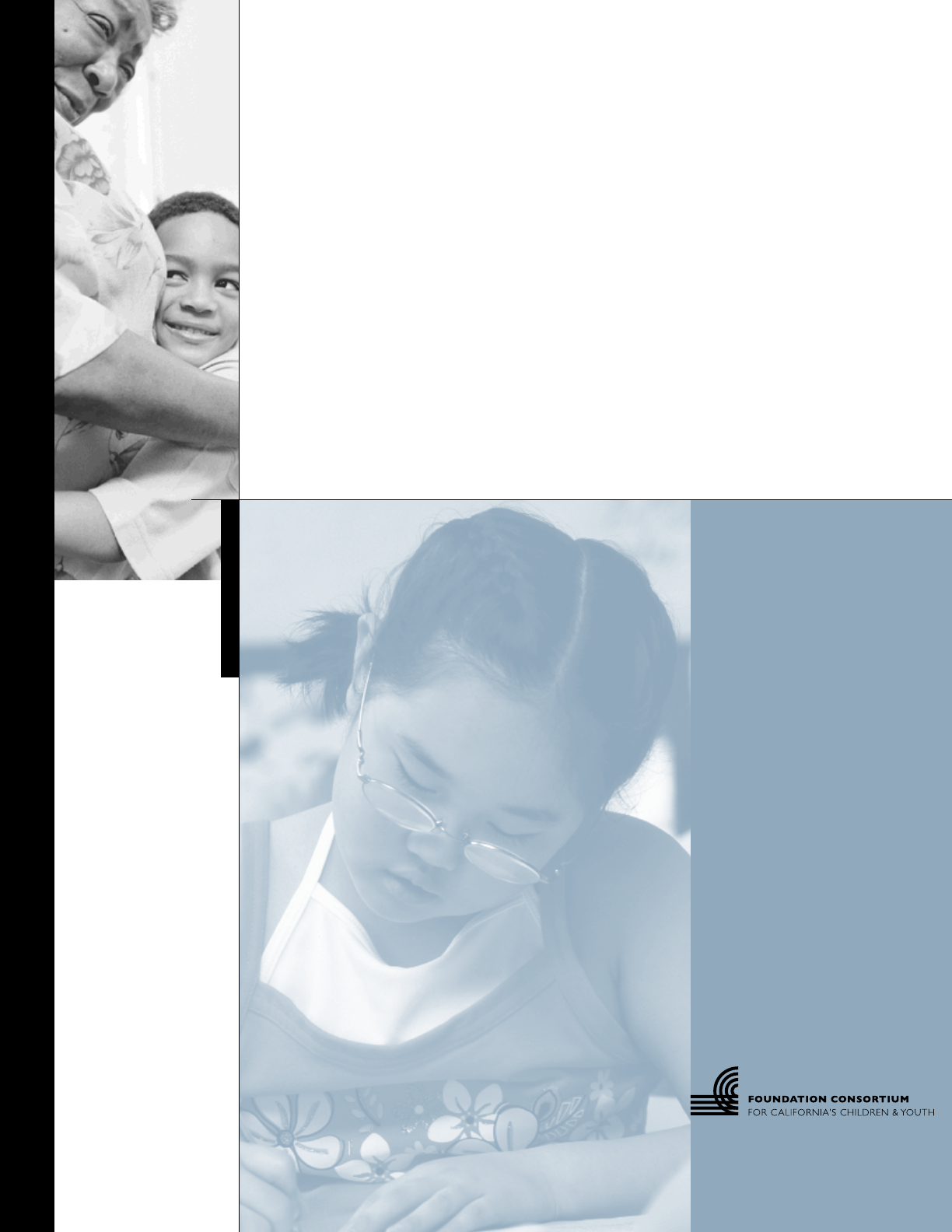
2
SECOND OF TWO BRIEFS
WhatWorks
Winter 2006
L E A R N I N G F R O M T H E F O U N D A T I O N C O N S O R T I U M
F O R C A L I F O R N I A ’ S C H I L D R E N & Y O U T H :
Foundation-Government
Partnerships
B Y J U D I T H K . C H Y N O W E T H
E D I T E D B Y M I C H A E L K R E S S N E R
The Foundation Consortium for California’s Children &
Youth is closing after fourteen years. This brave experiment,
unlike any other in the nation, served California from
1991–2005, left behind many accomplishments and birthed
three new entities. This policy brief is the second in a two-part
series that explores the Consortium’s experience. The first brief,
“Foundation Collaboration in Action” is intended as a guide
for those interested in starting and sustaining foundation
collaborations. It discusses the Consortium as a foundation
collaboration and focuses on critical success factors as well
as the reasons for its eventual demise.
This brief examines the Consortium’s primary strategy,
foundation-government partnership. It is written primarily for
a foundation audience, but public sector officials will find it
informative. It begins with the story of the Consortium, then
goes on to describe the benefits of foundation-government
partnerships, discuss evaluation challenges, and identify factors
associated with success. The heart of the brief presents key
lessons. It closes with some pointers on starting a partnership.
P O L I C Y B R I E F

The Foundation Consortium would
like to thank everyone who has
helped us over the years improve
outcomes for California’s children
and youth. Individually and in new
groups, we will continue to work for
positive change in our communities
and hope you will do the same.
Trim Line Does Not Print.

Trim Line Does Not Print.
Dear Friends of the Foundation Consortium for
California’s Children & Youth,
As most of you know by now, the Foundation Consortium will close
its doors after over 14 years of successful work on December 23, 2005.
That means you are now reading our last What Works Policy Brief. If
we counted right, this is brief number fourteen. What began with a
grant from The California Wellness Foundation for a series of four such
publications in 1998 became the Consortium’s primary print publication,
always focusing on what we care about most: good policies and their
implementation. We would like to thank all of the authors and review
teams for their fine work and you, the readers, for your loyalty and
support throughout the past seven years.
While the Foundation Consortium will end, many of its members
will continue to work together in different ways to help California’s
children be safe, healthy and learning each day. The ending of the
Consortium is in no way a reflection of diminished member
commitment to their own priorities and many of those the
Consortium has adopted, e.g. After-School, Child Welfare and
Family Support.
The Consortium’s website will stay alive until June 2006. Here
you can find information on our program areas (e.g., go-to places),
and the whereabouts and contact information of our staff. All of
our policy briefs are available for download as well. Please visit
www.foundationconsortium.org.
Last, but not least, I would like to thank the Board of Directors, our
partners, consultants and staff for their ongoing support and work.
Without you, the Foundation Consortium, would not have been able
to be one the most successful and longest-lasting foundation-governed
pooled funds in the country.
Judith K. Chynoweth
Executive Director
Foundation Consortium for California’s Children & Youth

partnership
Foundation Consortium for California’s Children & Youth
2
What Are the Benefits of
Foundation-Government
Partnership?
Leverage of Foundation Funds
Foundation-government partnerships have
a number of benefits for foundations, for
government and for the individuals, families or
communities the partnership seeks to help. For
foundations, the most alluring (and challenging)
benefit is the ability to leverage public
resources toward a desired policy goal.
Through the Healthy Start partnership,
Consortium member foundations encouraged
the expenditure of $10 million public dollars
(SB620) for a statewide program strategy they
themselves were supporting on a small scale.
Furthermore, a Consortium expenditure of less
than a million yielded hundreds of millions of
federal dollars for expanded children’s services
through the LEA MediCal Billing Option. In
the Child Welfare Partnership, Consortium
members leveraged $3.2 million in targeted grants
from the Marguerite Casey Foundation and the
California Endowment into approximately $6.5
million for a capacity-building process to help 40
counties implement a new response to families
reported to the child abuse hotline. In 2005,
AB2496 was passed to institutionalize the ability
of foundations to grant money to government to
match federal dollars for specific and allowable
purposes. This would not have happened
without a foundation-government partnership.
Quality Policy Implementation
Through partnerships, foundations and
governments can ensure quality implementation
of policies they support. The California
After School Partnership of the Foundation
Consortium and the California Department
of Education created a brand new approach
to building quality programs at the local level.
Instead of supporting a centralized office to
develop and deliver periodic trainings to diverse
sites throughout the state, the partnership
developed a decentralized system of field
support. This system brought hands-on coaching
to program sites — a “guide by the side.” In 11
regions in the state, it funded “leads” who are
accountable for program quality, broker local
training and provide technical assistance and peer
support. It designated and funded regional learning
centers that model quality programs and serve the
other sites in their region as peer learning centers.
Foundation-government partnerships can help
foundations and their government partners
learn to implement challenging policies.
Proposition 10 required local commissions to
include diverse groups in their planning and
decision-making and to be accountable for results.
Through partnering with The Foundation
Consortium, four First 5 county commissions
developed processes that included a highly diverse
group of community residents and providers. They
also developed accountability systems for their
grantees that focused on participant results and
program performance measures.
Improved Public Systems
A third benefit is improvement of public
systems. The Foundation Consortium partnered
with the California Department of Social Services
to support proposed improvements in the child
welfare system. Through this partnership 40
counties began implementation of differential
response,
1
a more individualized response to
families reported to the child welfare system. Local
inter-disciplinary, inter-agency teams around the
state are working to improve outcomes of youth
transitioning out of foster care. Partnerships
between county welfare agencies and community-
based agencies are taking joint action to provide
families with the help they need before abuse and
neglect occurs. Finally, proactive and positive
communications about child welfare activities are
being developed and coordinated at the state and
county level.

advocacy
What Works Policy Brief Foundation-Government Partnerships
Winter 2006
3
Prevention
Finally, foundation-government partnerships
enable government to stretch their prevention
dollars. Publicly funded services are generally
for individuals and families with the most severe,
chronic or complicated challenges. The Public-
Private Family Support Funders Group built the
capacity of community-based neighborhood family
centers to strengthen and sustain their programs.
This effort could not have been funded without
the resources and technical expertise of the
Consortium and its members.
Government partners have highly valued the
Consortium for its comprehensive policy
perspective, consistent push for accountability,
and willingness to spend time and money to solve
implementation challenges.
There are times, however, when a foundation-
government partnership does not make sense.
Partnerships break down when foundations
advocate for a policy not supported by their
government partners. For example, towards
the end of the Healthy Start partnership,
the Foundation Consortium pushed for the
accomplishment of the third partnership objective:
a system of comprehensive, integrated school-
linked services. The government partners were
not really interested in this policy objective, and
the more the Consortium reminded their partners
that this objective was a part of the partnership
agreement, the more uncomfortable and less
productive the overall partnership became.
Foundation-government partnerships are not
indicated as a strategy when either party wishes
to exercise a high level of control over activities
or when either party is in a hurry. Partnerships
take time to develop even when both sides
have partnership experience. Rushing to action
undermines the long-term success of partnerships.
Policy and Program Integration
Partnerships promote policy and program
integration across department and discipline
lines. The Consortium Policy Academies supported
19 county inter-agency teams to develop more
comprehensive child and family policy. The Child
Welfare Partnership formed a state interagency
team (SIT) at the deputy level to improve
outcomes for shared populations of children
and families. The SIT develops and implements
integrated state-level policy across multiple
agencies including social services, alcohol
and drug abuse prevention, physical and mental
health, education, employment and training,
developmental services and the Attorney General.
Additional Resources
For government, the most compelling benefit is
securing resources for critical activities that
have not been publicly funded. For example,
the California Department of Education did not
receive adequate funds from the state to support
technical assistance for local after school programs
when the After School Education and Safety Act
passed. Public funds for administering the Act also
were scant. Foundation resources helped with both
of these shortfalls as well as provided considerable
strategic advice and expertise. The California
Department of Social Services had no state
resources to support county capacity building
for differential response. The partnership enabled
private foundation dollars to be used as a match
for federal title IVE funds to support the
Breakthrough Series Collaborative that provided
technical support to counties.
Advocacy
A second but equally powerful benefit to
government is the voice of outsiders —
the foundations — pushing for policy
implementation and accountability already
desired by government administrators. The
Child Welfare Partnership helped to transition the
child welfare redesign recommendations from a
Democrat to a Republican administration. The
Partnership provided much needed focus and
continuity during the transition and persistently
reminded public partners of their longer-term
strategic goals.

opportunity
Foundation Consortium for California’s Children & Youth
4
T H E F O U N D A T I O N C O N S O R T I U M F O R C A L I F O R N I A ’ S C H I L D R E N & Y O U T H
— A S T O R Y O F A C C O M P L I S H M E N T S
In January 1992, the Chief Executive Officers of
eight California foundations signed an Agreement in
Principle with Governor Pete Wilson and the State
Superintendent of Public Instruction, William Honig.
The agreement was a public-private partnership to
support and influence public policy for children and
families. Specifically, the partnership was designed
to support the implementation of Healthy Start
(SB620), a discretionary grant for school districts
to build comprehensive, integrated, school-
linked services in elementary schools throughout
California. The first objective of the partnership was
to support the development and implementation
of Healthy Start. The second was to identify and
secure a source of ongoing funding for Healthy
Start sites once the three-year state grant period
expired. The third and most difficult objective was
to develop a statewide system of comprehensive,
integrated support services for children and their
families. The state contribution to the partnership
included administration, training for program
development and grants to local districts — a total
expense of about $10 million a year. The Foundation
Consortium contributed $1.7 million per year for
three years to support a statewide evaluation and
to develop the Local Education Agency MediCal
Billing Option, a local match for the federal Medicaid
funding stream.
Many lessons in public-private collaboration
were learned in this first partnership. The results
were well worth the risks to both partners.
Healthy Start
2
has a proven track record in
improving outcomes for children and their families
in California. Though Healthy Start state funding
has been eliminated, many Healthy Start programs
remain strong and vibrant in their communities,
supported by a combination of funds from school
districts, counties and foundations. The Consortium
is proud to be part of that success. For more
information on Healthy Start please visit the
Web site of the California Department of Education
(www.cde.ca.gov/ls/pf/hs).
The Consortium was the first ever pooled fund
governed by the state’s leading foundations. By
2005, Consortium membership had grown from
eight foundations to 19, with 23 member foundations
at its peak. The Consortium’s mission was to bring
philanthropy together with community, schools and
government to improve public policy and practice.
What held the Consortium’s members together was
a commitment to improving public policy and a set
of values. Staff and board were acting on the basis
of these values before they were even articulated.
However, articulation of these values reinforced the
Consortium’s vision and enabled it to communicate
that vision more effectively to government partners
and foundation boards. In brief, these values were:
■ Focus on the whole child within the context of
the family and community. Children and families
experience life’s challenges as an interrelated
whole, not as a series of categorical problems.
■ Be inclusive. Policy decisions must involve those
who are impacted, including service providers,
youth, families and community residents.
■ Be accountable for results. Funders must focus
primarily on community results, and programs
on participant outcomes.
■ Fund smart. Learn what works or what shows
promise. Gather and analyze data to learn what
works and stop funding what doesn’t.
Throughout its fourteen years the Consortium faced
many barriers to effective policy for children and
their families. The Consortium sought champions
within government who wanted to build capacity for
quality in local programs, create sensible financing
structures and get input from those typically left out
of legislative and administrative policy development.

accomplishments
What Works Policy Brief Foundation-Government Partnerships
Winter 2006
5
The work was all done through foundation-
government partnerships:
■ The Consortium provided technical support
to legislative staff working to develop AB1741,
known as the Youth Pilot Project. The legislation
authorized the Health and Human Services Agency
to offer selected counties the flexibility to blend
state dollars from selected programs to provide
more comprehensive, preventive services to
children and youth. In partnership with the Health
and Human Services Agency, the Consortium
designed, funded and directed a county policy
academy with the goal of helping nine counties
prepare for AB1741 selection. The academy was so
successful the Consortium funded a second round
involving an additional 11 counties. The academies
augmented the capacity of county inter-disciplinary
teams to collaboratively develop and implement
more integrated child and family policy at the
county level.
■ The California After School Partnership built
a decentralized system that redesigned the way
the California Department of Education supported
program quality at the local district level. After
School “regional leads” in 11 regions throughout
the state are responsible for supporting quality
after school programs through fund development,
local partnerships
3
, training and technical
assistance. Designated “regional learning centers”
— one or more per region — demonstrate
exemplary after school programs and are peer-
learning centers for other programs throughout
the region. Regional leads and learning centers
work together with individual sites to increase
program effectiveness and sustainability. In
addition, the Partnership laid the groundwork
for a statewide after school network, an inclusive
group of after school stakeholders that will
advocate for appropriate policy and advise a
legislatively mandated after school advisory
committee that reports to the governor and
the state superintendent.
■ The California Child Welfare Partnership
accomplished numerous objectives and spawned
additional collaborations. It launched the State
Interagency Team to integrate policy across
departments and agencies and to break down
barriers to effective policy implementation,
including increasing financing flexibility. It
established the Breakthrough Series Collaborative,
a major effort involving over 40 counties, whose
mission is to improve county and community
collaboration to assist families reported to the
child abuse hotline.
4
It coordinated the first major
strategic effort among state and county child
welfare agencies to proactively communicate
the positive results — grounded in data — of
improved child welfare policy and practice. This
included four major publications used as primary
reference by private and public funders alike.
5
And, the California Child Welfare Partnership
established a mechanism, authorized by the
legislature, to enable private funders to match
public dollars for improving the outcomes of
children and youth who are in foster care.
■ The Public-Private Family Support Funders
Group has taken a highly diverse, fragmented,
under-funded, under-developed field — the
family support field — and organized it into a
new association: the California Family Resource
Association. It has breathed new life into programs
by designing and testing a high quality curriculum
on sustaining quality family support programs.
The Consortium held four statewide conferences
entitled Pilots to Policy to emphasize the need
to replace pilot projects that come and go with
state policy that ensures consistent results for
children and families. It also urged three California
Policymaker Institutes to focus on results
accountability, particularly in the improvement of
child welfare and health. The Consortium published
thirteen policy briefs in total on how to strengthen
policy and practice for improved results. $30 million
over 14 years: Quite an investment and worth
every penny.

success
Foundation Consortium for California’s Children & Youth
6
What Does Success Look Like
for a Foundation-Government
Partnership?
How do you know a successful foundation-
government partnership when you see one? This
has been a tremendously challenging question for
both the members and the staff of the Foundation
Consortium. There are so many possible measures
of success. First, there are results for people,
programs and systems. Are the beneficiaries of
the partnership work any better off? Have agencies
changed the way they conduct business? Are systems
more comprehensive, integrated, preventive?
Second, did the partnership achieve its objectives?
Third, it is important to look at the process of the
partnership itself. Is communication among partners
frequent, direct and honest? Are partnership
decisions transparent to each partner and to
others with whom they work?
Then there is the issue of attribution versus
contribution. Did the partnership make a critical
difference or did it merely take credit for an
accomplishment of some other entity or force?
How can we know if partnership work contributed
to an accomplishment? Can the level of contribution
be measured?
The Foundation Consortium has spent considerable
sums on and experimented with many different
evaluation methods throughout its history. Here
are some of the approaches that have been tried:
A $1.5 million evaluation of Healthy Start
programs conducted by Stanford Research
Associates (SRI) produced data that were
used repeatedly in support of continued
program funding.
An outside evaluation of county capacity building
for system change (County Policy Academy)
conducted by Brizius and Foster confirmed the
value of the academy process in helping county
departments and agencies work together to plan
more comprehensively for children and families.
ß
ß
An assessment of county programmatic and
administrative changes to make services more
comprehensive, integrated and flexible for
families. Through surveys and key informant
interviews Philliber Research Associates defined
these systems changes, but could not attribute
the change to Consortium activities.
A summary analysis of California local after
school evaluations and state evaluation data
prepared by U.C. Irvine documented improved
outcomes for participating students as a result of
the program and made the difference in building
legislative support for continued funding.
Applied Survey Research evaluated the Results
for Children Initiative, a partnership between the
Consortium and four county First 5 commissions.
The outside evaluation of the Child Welfare
Partnership by the National Health Foundation
documented the importance of the partnership in
maintaining focus on child welfare improvements
during an administrative transition.
The Consortium director’s report on work plan
performance measures informed the board of
accomplishments and trouble spots needing
course correction.
Despite their utility, these various efforts of
measuring results still left most Consortium
members (and staff) dissatisfied. Though each
evaluation demonstrated positive results, none
could demonstrate overwhelming success.
Furthermore, the Consortium could not prove its
contribution really made the difference. Separately
or together, the evaluation results did not tell a
powerful story that helped the collaborating
foundations communicate to their constituencies
“Wow! This partnership is really worth the effort.”
ß
ß
ß
ß
ß

measurement
What Works Policy Brief Foundation-Government Partnerships
Winter 2006
7
Measurement as a Learning Tool
In spite of these challenges, the Consortium
learned a lot from the evaluations it conducted:
Legislatively mandated initiatives that do
not specify desired results have a hard time
demonstrating their success. For example, was
Healthy Start about meeting children’s health
needs, meeting basic family needs, improving
children’s academic achievement or increasing
family involvement in the schools?
Outcomes of comprehensive initiatives (such as
Healthy Start) are very challenging to measure.
Statewide evaluations of local programs (such
as Healthy Start) are expensive and challenging
to design in a way that responds flexibly to
local needs and circumstances while yielding
comparable data across programs or counties.
A partnership’s ultimate outcome can be complex
and quite distant in time. Interim accomplishments
frequently are process measures and do not
generate the kind of excitement sometimes
needed to keep partners motivated. In addition,
the relationship between partnership activities
(interventions) and desired results may not
be direct.
Systems change is difficult to measure and
very difficult to attribute to any single entity
or group of interventions.
California legislators hold state agencies
accountable for results, but often do not allocate
resources to support rigorous evaluation. As
a result evaluation data from local programs
can sometimes sit in cardboard boxes for
extended periods of time because the agency
is unable to analyze the data or use it for
continued program improvement.
One can better measure the success of capacity-
building initiatives if baseline information is first
gathered on what participants know and can
do at the beginning of an initiative and is later
compared to what participants know and have
done at the end. Such an approach really informs
future efforts.
ß
ß
ß
ß
ß
ß
ß
An outsider’s evaluation of the foundation-
government process is extremely helpful
to the partnership — especially during a
partner transition.
Should foundations give up on evaluating
partnerships? Absolutely not. At a minimum,
it is important to know if you accomplished
what you set out to and if the “customers” of
your effort were satisfied. For example, in the
First 5 Partnership, the Consortium was successful
in helping four county commissions build more
inclusive planning and governance processes and
in helping the commissions learn how to hold
their grantees accountable for results. However,
it was less successful in helping the commissions
hold themselves accountable for results. The
Consortium learned that it did not offer enough
technical advice on implementation of results-
based accountability. This finding led the
Consortium to develop the Guide to Results
Oriented Community Change.
2
An internal performance measurement system
for the partnership, accompanied by honest self-
appraisal, can produce very valuable information.
This requires the partnership to develop a work
plan with performance measures for each specific
activity it engages in. Partnership staff can design
data collection processes for the performance
measures and review progress quarterly. At the
end of each year, performance against expectations
is summarized and accomplishments are reported.
The remaining question is both relatively
straightforward and tremendously important:
What convinces the members of a foundation-
government partnership that its results justify the
costs? Consortium experience shows that in the
absence of definitive data, a good story will do.
More and more evaluators understand that data
and stories are best for convincing funders — both
public and private. The Consortium “story” is at
the beginning of this brief.
ß

six lessons
Foundation Consortium for California’s Children & Youth
8
Six Lessons for Foundations that
Wish to Partner with Government
Lesson 1: Be humble. Know yourself and
your partner.
It takes humility to be a good partner. Just
accepting that you cannot dance alone takes some
humility. Once the partnership gets underway,
however, it is easy for both partners to lose
perspective and to think: “I deserve to lead this
dance. My partner should just follow my lead.”
This type of thinking creates serious challenges for
foundation-government partnerships — especially
if one partner does not know or understand the
context of the other. Here are five points that
foundation partners need to remember:
The policymaking process is chaotic and
uncontrollable. Protect your interests but be
flexible — learn to live with bumps and sudden
changes of direction (and administration).
Understand how public policy issues arise, turn
into policy proposals that ultimately pass (or fail)
and become implemented and how this cycle
relates to public attention. Take a look at the chart
on page 13 and ask yourselves, “Where on this
chart is the issue we want to partner on? Given
where the issue is, what activities should we be
helping our government partners to accomplish?
What activities should we be anticipating?
Don’t expect government to be accountable in
the same ways foundations are. The public sector
has a much wider range of constituencies and
needs than you do. In government, accountability
rests with the voters and those who get the votes.
As a foundation, don’t expect to drive partnership
accountability. You didn’t get any votes.
No matter how much you know, no matter how
non-partisan you think you are, no matter if you
wear the “good government” hat, among some
people in government, you are still just another
special interest.
No matter how big your foundation endowment,
your partnership contribution is just a rounding
error in a big public budget. You are a flea on the
elephant’s back.
ß
ß
ß
ß
ß
Once upon a time there was a flea who lived
on the right ear of a big, powerful elephant
that worked in a forested region in India.
The elephant spent all day doing many
important jobs in the forest and for the
people in the villages on the edge of the
forest. He pulled up trees for building huts
and for firewood. He helped to make roads
and build houses.
Now, while elephants are smart, they need
to be managed. This elephant had a mahout
who sat upon his back and told the elephant
where to go and what to do. The mahout
got the elephant started in the morning, gave
him instructions all day, and in the evening
he led him to a forest river to bathe and cool
off. Without the mahout to direct him, the
elephant sometimes got confused or decided
to go off on his own. This could be quite
a disaster for the forest and the villagers.
One time he ran amuck through the town
ripping huts apart, wrecking the marketplace
entirely and even accidentally crushing a few
innocent bystanders.
The flea remained calm no matter what the
elephant did except, of course, when the
elephant splashed in the river and got him
wet. He sat very high up on the elephant and
from his vantage point he learned a lot about
the forest and the villages. He could see what
the villagers had and what they needed. But,
while he knew a lot, he was a bit of a foolish
flea. Somehow, he got the idea that he could
actually influence the elephant to do what he
thought was best for the villagers. He began
hollering directions into the elephant’s ear.
As long has the flea’s directions matched the
mahout’s directions things went well.
T H E S T O R Y O F T H E F L E A
A N D T H E E L E P H A N T

persistence
What Works Policy Brief Foundation-Government Partnerships
Winter 2006
9
The flea began to feel like he was telling the
elephant what to do:
“Turn left here, Elephant.”
“Take this wood to that family who
needs to build a house.”
“Don’t muddy the river right now,
Elephant, the women need to wash
their clothes.”
When the elephant did what he said the flea
puffed out his chest and felt very proud. “I
am a fine fellow,” he thought. “I have much
more power than an ordinary flea.” He knew
a lot and he had good intentions, but, as I
said, he was a foolish flea.
One day, the elephant was involved in build
-
ing school huts in the villages on the edge of
the forest. The huts were places the children
could go near the school when they needed
help or to just to relax and have fun when
their lessons were over. The elephant built
huts in two villages and the flea could see
that the children really liked the huts. The
flea was excited and spent hours offering his
wisdom and directions, which he mistakenly
thought the elephant was really listening to.
He was looking forward to school huts in
every village, full of happy, playing children.
But one morning, as he was waking up and
stretching all his many legs and yawning his
proboscis, he noticed that his Elephant was
not walking to the next village to build a
school hut. Instead, the Elephant was helping
other elephants build a new road in the
forest far away from the village that needed
the school hut. This was very upsetting
to the flea. He knew the children in the
remaining villages needed school huts.
What was he going to do?
He thought to himself: “Maybe my friend the
Elephant forgot what he is supposed to be
doing.” He crawled close to the elephant’s
ear opening and shouted as loud as he
could: “GO BACK TO THE VILLAGE AND
BUILD THE NEXT SCHOOL HUT.” But the
elephant kept right on pulling logs onto the
dirt road. So the flea jumped right into the
elephant’s ear and bit him as hard as he could
on the softest place he could find. “That will
make him listen up,” he thought. “I know
what is best for the children in the villages.”
Well, the elephant trumpeted loudly. He
shook his big head from side to side. He
flapped his right ear again and again. “What
is wrong with you today?” asked the mahout
in a soothing voice to the elephant. I must
calm you down or soon you will run amuck.”
So he leaned forward and lifted up the
elephant’s ear and peered in. “Oh,” he said,
“There is a flea on your ear right on this
tender spot.” And he put his thumb and fore
-
finger together picked off the flea and threw
it on the ground.
The flea was indignant and for just a moment
thought of fighting back. Then he saw the
elephant’s very big feet about to crush him.
“I’d better get to a safe place,” he thought
and he ran under a log as quick as ever he
could. “I guess I’m just a tiny flea compared
to this big elephant,” he thought. But when
the elephant (and the mahout) weren’t
looking he jumped back on the elephant’s
leg and began the long climb up. “Hum,” the
flea thought as he climbed. “I guess I’ll have
to think of a different way of getting the
elephant’s attention.
Moral: Don’t think you have more
power than you do. Strategic direction
and persistence work better than bravado.

realistic
Foundation Consortium for California’s Children & Youth
10
You cannot leverage a boulder with a toothpick.
The Consortium once held a meeting with six
counties to discuss systems change for children and
families. Near the end of the meeting one county
administrator raised his hand and said, “This is
all very well and good, but what you have outlined
will take about 20 years.” He was trying hard
to be polite and not laugh at us. It turns out he
underestimated the job. At the end of 14 years of
existence, the Consortium still hasn’t accomplished
all the “system changes” it envisioned.
Building comprehensive solutions is harder than
anyone thought. It is easier to think than to act
comprehensively and probably more important.
Over time, Consortium objectives became more
specific and realistic:
A statewide system of comprehensive, integrated
school-linked services became a statewide
association of community-based, neighborhood
family centers.
Comprehensive school-based programs for
children and
families became after school
programs that focus on mentoring, homework
assistance and youth development.
Countywide systems change for families
and children became county-community
partnerships to provide a more individualized,
preventive response to families who have been
reported to the child abuse hotline.
Here are two important lessons:
Spend time on the front end of the partnership,
defining very specifically what goals and objectives
mean to each party. Your understanding of them
will change over the life of the partnership and
differences will arise. At least you will know that
you did have common ground at one point. That
can help you through the rough times as you
refine your objectives.
ß
ß
ß
ß
It also helps for foundations to share with their
government partner some things about their
culture. For example:
Philanthropy works hard to be smart. Foundations
invest heavily in knowledge development and are
eager to share what they know.
Philanthropy can be nimble and flexible in
getting resources, executing contracts,
responding to needs, changing directions.
Philanthropy is devoted to doing “right.”
Compromise is not a well-honed skill and
in some foundations not even valued.
Foundations have resources, particularly for
things government cannot fund, like capacity
building, research, evaluation and demonstration
projects. Foundations will go a long way to
leverage their resources with public dollars.
Funders do not like to be told to “leave their
money on the stump and walk away.” Many
want to be involved in building a solution.
Government cannot make foundations do
anything. It cannot starve them or mandate any
specific action. Foundations are stubborn. They
last. They will be around when a politician loses
the next election or gets “termed out.”
Lesson 2: Be realistic about what you want
and can accomplish.
Clear objectives are a must for any partnership.
Written agreements are necessary but not sufficient.
The memorandum of understanding between the
Foundation Consortium and the Governor and
State Superintendent had three clear objectives.
The problem was nobody really knew what the
third objective -“Create a statewide system of
school-linked services” — meant. The lack of
agreement on the meaning of this objective was
the death knell of the Healthy Start foundation-
government partnership.
You may be clear on your objective — for example,
make county systems that serve children and
families more comprehensive, integrated and
preventive — but your expectations can be out
of sync with your resources or your time line.
ß
ß
ß
ß
ß

communicate
What Works Policy Brief Foundation-Government Partnerships
Winter 2006
11
Match expectations to resources. See the big
picture. Think comprehensively. But, focus,
focus, focus. Do what you have the ability and
resources to do and celebrate that. If you share a
vision, others will pick up where you left off. A
well-articulated vision also can draw other resources
to support additional parts of the implementation.
Lesson 3: Communicate, communicate,
communicate.
Over the Consortium’s history, communications —
telling stories well — became a key feature in
partnerships with government. The first partnership,
Healthy Start, had no communications component
at all. The After School Partnership developed a
name and logo and included several press events.
The Child Welfare Partnership had a strategic
communications plan with state, county welfare
and consortium partners, press kits, fact sheets, and
op-ed pieces. The Consortium invested heavily in
communications expertise for the new California
Family Resource Association.
One of the most important lessons the Consortium
has learned in partnering with government is
that foundation partners must be prepared to
communicate their policy agenda in terms that
make sense to both elected and appointed officials.
The truth is most elected officials are interested
in what their constituents want — at least those
who vote. Foundations do not vote. They cannot
contribute to campaigns. Public officials must pay
attention to what their bosses — the governor
or state superintendent — want. Foundations
must be able to tell a story about people, what
they need and want, what will help them, and
how a foundation-government partnership can
make a difference.
Most foundations do not have communications
expertise on staff. Furthermore, most foundation
trustees are reluctant to make communications
grants. Communications expertise in a foundation-
government partnership is essential. It is not
a luxury.
ß
Lesson 4: When partners change, adjust.
Expect change in a partnership. In general, change
happens more frequently in government than in the
foundation environment. Throughout its govern-
ment partnerships the Consortium experienced:
Three governors.
Three state superintendents.
Four Secretaries of Health and Human Services.
Numerous department directors, deputy
directors and other administrative changes.
Yet partnerships depend upon personal relation-
ships. Here are several lessons the Consortium
has learned about changing partners in a
foundation-government partnership:
Be aggressive about meeting with the new partner.
No matter how busy the new appointee is, no
matter how many pressing priorities they have,
contact them right away and schedule a face-to-
face meeting.
Prior to a meeting prepare written communication
that briefly describes the history of the partnership
and its accomplishments to date.
Be direct with your new partner about:
the goals of the partnership
what you need from them for the partnership
to remain successful
what parts of the agreements with the
previous partners must remain in place
for the partnership to be viable for you
what parts you can be flexible about
Be willing to let go. If after a few face-to-face
meetings you still get signals that the new
partner does not understand or put a priority on
the partnership, request a face-to-face meeting to
politely but formally end the partnership. You
don’t need to threaten. It is not personal. Just let go.
ß
ß
ß
ß
ß
ß
ß
ß
ß
ß
ß

change
Foundation Consortium for California’s Children & Youth
12
Lesson 5: Watch where you are going — it
will change over time.
Foundation-government partnerships change.
Even if the strategic goal of a partnership is well
defined and agreed upon by all partners, shifts in
direction are inevitable. The California After
School Partnership wanted after school programs
to achieve results such as improved academic
achievement and more positive choices by
participating youth. The Consortium knew that
it took well-funded, quality programs to achieve
those results, but our under- standing of how to
achieve quality changed. Over time it became clear
that program staff learned quality by being coached
and mentored, not just by being “trained.” It made
a difference for program staff to visit an exemplary
program site to see, touch and feel — not just hear
about — “quality.” Furthermore, after school
program leaders needed to define quality for
themselves and not have indicators picked for
them by funders. The partnership discovered that
the road to quality was a lot more complicated
than we thought.
As previously mentioned, partners change. The
new partner wants to remain in the partnership
but change the goal — perhaps focus on a
particular aspect of the original goal. The Child
Welfare Partnership with the Davis administration
was focused on Child Welfare Redesign — broad
changes in how child welfare services were
delivered, including partnerships with community
agencies to prevent child abuse and neglect from
occurring. The Schwarzenegger administration
narrowed its focus to three child welfare system
reforms: child safety, differential response to
families reported to the child abuse hotline and
permanency and improved outcomes for children
in the system and youth transitioning out of it.
They wanted to remain in a partnership with the
Foundation Consortium and continue the work
on interagency coordination and communications,
but prevention was not a priority for them. The
partnership redefined its goals and continued.
Watch where you are going in a foundation-
government partnership:
Be strategic: never loose sight of your ultimate
goal.
ß
Be tactical: understand your environment and
how changes impact your ability to achieve your
strategic goals.
Remember, purpose is no substitute for process.
You have to be able to negotiate obstacles in your
path. This takes all the process skills that myriad
publications about partnership cite over and over:
leadership, open and honest communication,
mutual respect, highly skilled meeting facilitation,
governance that defines conflict management,
inclusive planning and patience.
Lesson 6: Be persistent. But be willing
to let go.
The longest foundation-government partnership
the Consortium participated in was five years: The
California After School Partnership. By the end,
we were just hanging on to each other, all our
energy and enthusiasm drained. We had no
common direction because we had difficulty even
communicating. Obviously, persistence was not
enough. The Consortium made a decision, with
its partners, to end the partnership. We left as
we started — in good faith. Because of that the
Consortium has been able to continue its after
school work even though the California After
School Partnership ended.
Here are four important signs that the partnership
is in trouble:
Your partner is saying one thing to you and
doing another.
Decisions are not being made in a timely
manner or there is no follow-through.
Meetings are tough to schedule and decision-
makers do not attend.
You realize that you and your partners no longer
have shared goals.
If you make several efforts to address these issues
with no improvement, it is time to end the
partnership. Be up-front with your concerns.
Take a measured pace. It took the Consortium
and the California Department of Education
almost nine months to end the partnership.
ß
ß
ß
ß
ß
ß

intention
P O L I C Y L I F E C Y C L E
First Evaluation Results
Re-Authorization
On-Going Implementation
Phase One Implementation
Enactment/Program
Development
Education
Building Support
Awareness
R E S P O N S E I N T E N S I T Y
T I M E
What Works Policy Brief Foundation-Government Partnerships
Winter 2006
13
Ready… Set… Go!
Getting Started
The Consortium hopes that many more foundation-
government partnerships get started. Such partnerships
achieve results, can leverage millions in public funds
and make government more effective. On top of that
they are exciting and rewarding.
Get Ready: Ask Yourself Four Questions
What is your purpose? If you want to influence
policy and its implementation you need to
understand the policy cycle.
Are you trying to build public awareness of a
problem or a public policy solution to that problem?
Are you educating others about general solutions or
providing technical advice on a specific solution
such as legislation or a county executive order?
Perhaps you are interested in making sure that a
specific policy solution actually achieves the results
intended. Are you trying to re-awaken the public to
the fact that a problem was not actually solved?
Ride the policy wave. In its Healthy Start
and After School Partnerships the Foundation
Consortium rode the rising crest of policy cycle.
We offered technical advice to legislators, conducted
general policy education and provided support for
quality implementation of passed legislation for
three and five years respectively. In child welfare, a
California Policymaker Institute called attention to
an emerging problem and helped move stakeholders
to action. The Consortium created the Child Welfare
Partnership during the developing phase of the policy
cycle and continued through policy implementation.
The Public-Private Family Support Funders group
worked at the emerging end of the policy wave,
building the capacity of neighborhood family
centers to raise public awareness about problems
facing families — particularly poor and immigrant
families — and advocate for neighborhood family
centers as a solution.
What is your intention? Intention is different
than purpose; it is subtler. Be clear about your
motivations. Do you want just to share information
or powerfully influence a government course of
action? Are you open to joint discovery of the right
approach or do you know it all? Don’t imagine you
can manipulate government. Be transparent about
your motivations.
What do you need to make the partnership work
for you? As a foundation, you are accountable to
your Board of Trustees. Foundation boards differ
greatly. Before you build your partnership, be clear
about what your board needs to know to feel
successful in this partnership. Make sure you can
get this in the partnership. If a potential public
partner is not willing to help you get it, the
partnership is doomed from the start.
What are you offering? How much money can you
put on the table? Is it sufficient to be attractive to
public partners? Is your money the only way they
can accomplish an activity they are committed to?
Perhaps your potential government partner wants
technical expertise or information you can access or
develop for them. Sometimes, potential government
partners want to build internal support for a policy
approach and they want to use your knowledge and
expertise to convince key policymakers. It helps to
know about the motivating factors of potential
government partners, but be clear about what you
yourself are offering.

relationships
Foundation Consortium for California’s Children & Youth
14
Get Set
Approach your potential partner. Relationships
make or break a partnership. At the start of every
Consortium partnership somebody in a foundation
knew somebody in government. It can be a
legislator, senior public official, county supervisor
or agency head. If you do not have a relationship,
start one. Ask for an appointment with a public
official. Go to the appointment with someone who
already has a relationship with that official. Invite a
policymaker to meet with your board. Focus your
interaction on discovering what goals you might
have in common. Gather information on your
potential partner’s way of operating. If you are
going to play a lead role in the partnership, what
does your “gut” tell you about how you will get
along with a potential partner? Pay attention to
what your gut says. A solid relationship between
individuals can carry a partnership through some
unexpected rough spots in the dance.
Make “the ask.” Here are three examples based on
Consortium experience:
“We see that you are charged with implementing an
after school program with very little administrative
dollars and no funds for technical assistance. We
would like to work with you to provide support
for quality programming and support to build
the policy voice of the new after school field.
Are you interested?”
“The Consortium is really interested in community
partnerships between county agencies and community
organizations to improve outcomes for children and
families. We noticed that community partnership is
a key component of your proposed Child Welfare
Redesign. Could we work together to support
implementation of the Redesign in a way that would
ensure community participation and partnerships?”
“We see that you spend a considerable amount of
public dollars on family support programs around
the state. Would you be interested in working with
several private foundations that are also interested
in family support programs? We would like to
see if public and private funders have some
common interests around strengthening the
field of family support.”
The final design of each partnership looked different
than what we had imagined at the time we asked
the question. In each case, however, the question set
the stage for a very satisfying (and productive) dance.
Sign. A formal signed partnership agreement
or joint work plan is a must — especially if the
partnership is going to last for more than six
months. The partnership may not stick with the
formal agreement or work plan. The contents
may change over time. However, a signed, joint
agreement or work plan yields several benefits:
The process of developing the agreement helps
the partners to clarify their goals and objectives.
It uncovers each partner’s real intentions (if you
listen carefully). It builds relationships because
during the process disagreement is bound to
occur. The emerging partnership can test its
approach to dealing with conflict.
The written agreement creates a common history.
If the partnership drifts or if individual members
change, the agreement recalls the original purpose.
It forms the basis for communication with others
about the partnership.
The agreement or work plan reinforces
accountability within the partnership.
Commitments of dollars and other resources
are on the record. Partnership policy and
procedures are clear.
Common components to a partnership agreement
or work plan include:
The purpose, goals and objectives of the partnership.
Joint activities and a timetable.
The commitments each partner makes to
each major activity: dollars, staffing, and
technical expertise.
Governance process, including conflict resolution.
Major partnership policies such as
communication with the public or media.
Now, you are ready. You are set. All you have left to
do is expect unpredictability, be flexible, work hard,
have fun and don’t take it personally.
ß
ß
ß
ß
ß
ß
ß
ß
ß

The Consortium wants California’s children to be safe,
healthy and learning each day.
Established in 1991, the Foundation Consortium for California’s
Children & Youth is a non-partisan resource bringing philanthropy
together with community, schools and government to improve
public policy and practice. The Consortium is a pooled fund of
21 of California’s leading foundations. Foundation members are
independent, yet they share common goals and the strategy of
public-private partnerships.
Judith K. Chynoweth, Executive Director
Michael Kressner, Communications Director
About the Author
Judy K. Chynoweth has been the Executive Director for the
Foundation Consortium for California’s Children & Youth since it
was established in 1991. Ms. Chynoweth is a nationally recognized
expert in strategic policy development, collaborative planning,
foundation-government partnerships, and public policy affecting
children and families. She now is working as a consultant from her
home in Chester, California. She can be reached at 530.258.2354.
Acknowledgements
The Foundation Consortium gratefully acknowledges the
contribution of the following individuals who assisted in
the process of writing and editing this brief: Miryam Choca,
Susan Brutchy, Ruth Holton, Marianne Kugler, Margaret Laws,
Kathy Lewis, Rita Saenz, Jay Scheniver, Gary Yates, and
Deanna Zachary.
Members of Foundation
Consortium for California’s
Children & Youth
The California Endowment
The California Wellness Foundation
Casey Family Programs
The Annie E. Casey Foundation
S. H. Cowell Foundation
The East Bay Community Foundation
Bill & Melinda Gates Foundation
Evelyn and Walter Haas Jr. Fund
William and Flora Hewlett Foundation
The James Irvine Foundation
Marin Community Foundation
Orfalea Family Foundation
The David and Lucile Packard
Foundation
Lucile Packard Foundation for
Children’s Health
Peninsula Community Foundation
The San Francisco Foundation
Santa Barbara Foundation
Charles and Helen Schwab Foundation
Sierra Health Foundation
Y & H Soda Foundation
Stuart Foundation
Sources of More Information:
Collaborative Philanthropies: What Groups of Foundation Can Do That Individual Funders Cannot, Elwood Hopkins, Lexington Books, 2005
Child Welfare System Improvements in California, 2003–2005: Early Implementation of Key Reforms. December 2005
The Foundation Consortium for California’s Children & Youth: Foundation Collaboration in Action. By Judith K. Chynoweth. December 2005
After School Public-Private Partnerships. By Marianne Russell Kugler. Ph.D. December 2005
Choosing the Path Less Traveled: Strengthening California Families Through Differential Response. By Patricia Shene, Ph.D. and Stuart Oppenheim.
Edited by Cathy Senderling. July 2004
Mutual Assistance: Galvanizing the Spirit of Reciprocity in Communities. By Yoland Trevino and Roland Trevino. November 2004
Getting the Job Done: Effectively Preparing Foster Youth for Employment. By Linda Lewis. October 2004
The Child Welfare System Improvement and Accountability Act (AB 636): Improving Results for Children and Youth in California. By Barbara Needell
and Ken Patterson. August 2004
Community Partnerships: The Living Legacy of Healthy Start. By Lisa Villarreal with Joanne Bookmyer. April 2004
Smart Cuts or Dumb Cuts: Family Support Programs in Tight Budget Times. By Sid Gardner. March 2003
Inclusive Governance: A Call to Action. By Hedy Nai-Lin Chang and Judy Chynoweth. September 2000
Reforming Finance/Financing Reform. By Mark Freidman, Fiscal Policies Studies Institute. January 2000
Making a Difference for Children and Families: The Community Approach. By Tia Melaville. November 1999
Getting to Results: Data-Driven Decision-Making for Children, Youth, Families and Communities. By Jacqueline McCroskey. March 1999
Citizens Making Decisions: Local Governance Making Change. By Frank Farrow and Sid Gardner. March 1999
F O O T N O T E S
1
Choosing the Path Less Traveled: Strengthening California Families Through Differential Response. By Patricia Shene, Ph.D. and Stuart Oppenheim.
Edited by Cathy Senderling. July 2004
2
Community Partnerships: The Living Legacy of Healthy Start. By Lisa Villarreal with Joanne Bookmyer. April 2004
3
The Guide to Results Oriented Community Change will be available on the Consortium’s Web site (www.foundationconsortium.org) from
1/3/2006-6/30/2006 and subsequently located on the Web site of the California Family Resource Association. (www.californiafamilyresource.org)

What Works
P O L I C Y B R I E F
www.foundationconsortium.org
www.promisingpractices.net
Prsrt Std
U.S. Postage
PAID
Permit No. 333
Sacramento, CA
